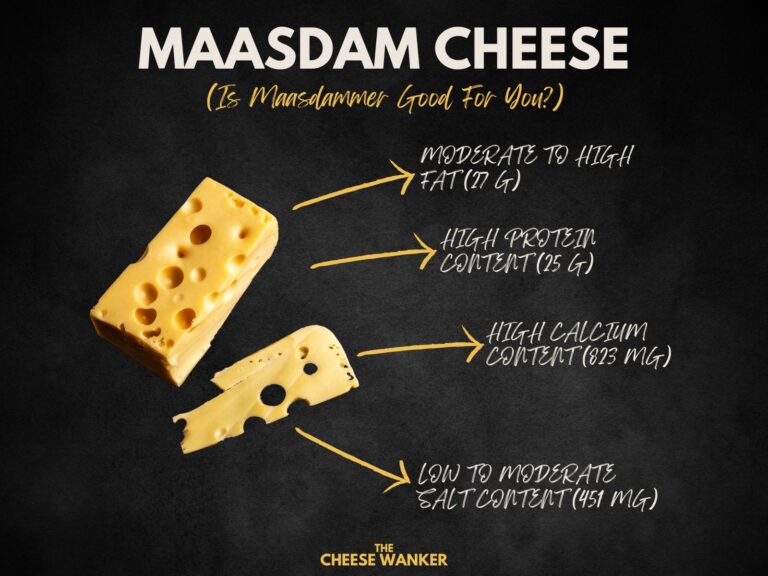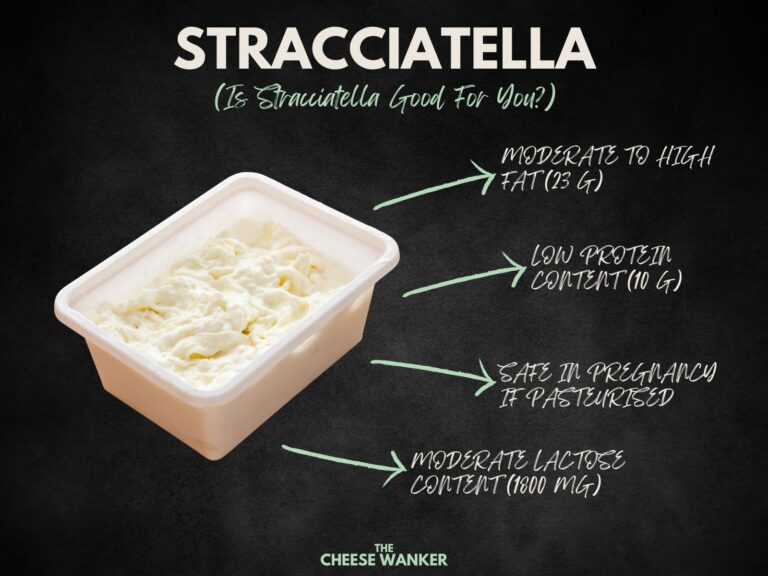Welcome to a tantalising exploration of the nutritional wonders hidden within the creamy folds of Jarlsberg cheese. In this blog post, we embark on a voyage to uncover the fascinating nutrition facts of Jarlsberg, a cheese renowned for its exceptional flavour and versatile culinary presence.
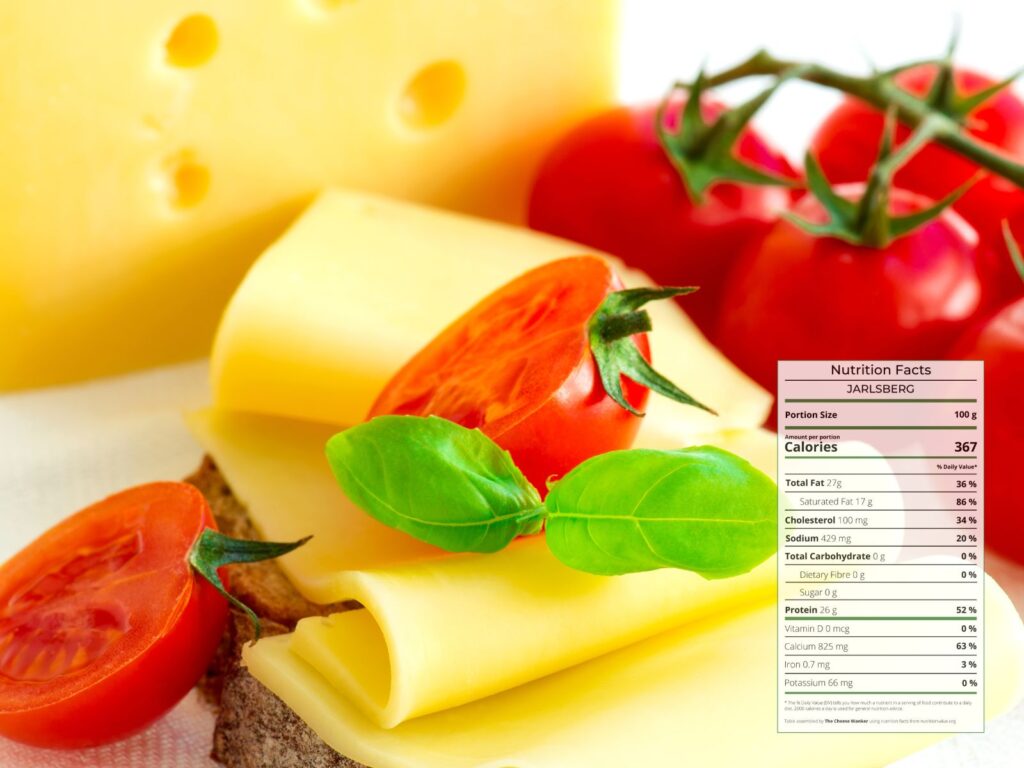
SEE ALSO: Nutrition facts for popular world cheeses in The Cheese Wanker’s index →
What is Jarlsberg?
Jarlsberg cheese, originating in Norway, is a testament to cheese craftsmanship and heritage. Named after the noble title “jarl“, this cheese carries with it the legacy of its roots.
Its organoleptic properties are a sensory delight, with a pale, buttery hue, a smooth texture, and characteristic round holes. The taste journey begins with a subtle, nutty sweetness that transitions into a creamy, slightly tangy finish. Its aroma is inviting, featuring notes of roasted hazelnuts and mild earthiness.
Serving Jarlsberg cheese is an art; it’s best enjoyed at room temperature and paired with fruits, crackers, or freshly baked bread. Whether melted into a comforting sandwich or featured in a culinary masterpiece, Jarlsberg’s versatility and timeless appeal continue to captivate palates worldwide.
Nutrition fact sheet
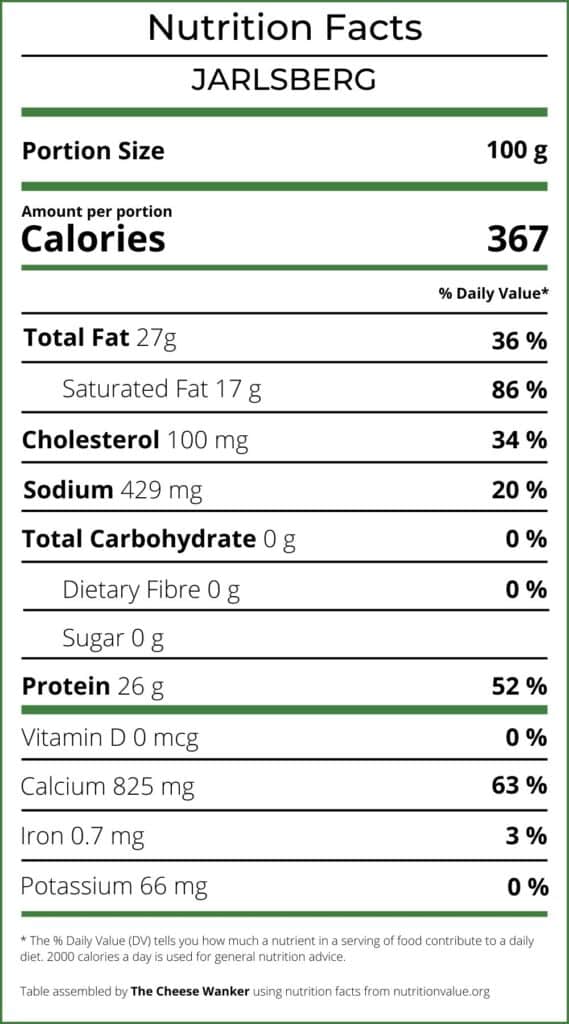
Country of origin
Norway
Type of Cheese
Milk
Cow
Examples
Jarlsberg Slices, Jarlsberg Lite, Jarlsberg Special Reserve
Safe
Keto Diet, Lactose Intolerance, Pregnancy
Avoid
Nutritional review for Jarlsberg
Eating healthy plays a pivotal role in maintaining overall well-being and preventing chronic diseases. A balanced and nutritious diet provides our bodies with essential vitamins, minerals, and macronutrients, fuelling optimal physical and cognitive function.
With this in mind, let’s have a look at some of the key nutrition facts for Jarlsberg.
Lactose Intolerance
For those grappling with lactose intolerance, the quest for dairy delights that won’t trigger digestive discomfort is a perpetual challenge. Enter Jarlsberg, a savoury solution with its lower lactose content.
The cheesemaking process transforms lactose into lactic acid, rendering Jarlsberg more digestible for many lactose-intolerant individuals. This moderate lactose content often falls within the tolerance range for a substantial portion of those with lactose sensitivity, allowing them to savour this cheese without worry.
Whether you’re creating a cheese platter, a hearty sandwich, or experimenting in the kitchen, Jarlsberg’s gentle impact on digestion opens up a world of culinary possibilities for lactose-intolerant individuals.
While tolerance levels can vary, Jarlsberg stands as a welcoming option that brings the pleasure of dairy back to the table, adding a touch of creamy delight to lactose-free lifestyles.
Fat Content
Jarlsberg, with its 27 grams of fat per 100 grams, offers a fascinating glimpse into the world of dietary fats and their impact on health.
Saturated Fats: Jarlsberg contains some saturated fats, which, when overconsumed, are associated with cardiovascular health concerns. However, these fats are essential for cell structure, energy and the absorption of fat-soluble vitamins.
Unsaturated Fats: The majority of the fat in Jarlsberg is unsaturated, including monounsaturated and polyunsaturated fats. These fats are renowned for their heart-healthy attributes. They help reduce LDL cholesterol levels, lowering the risk of heart disease and supporting various bodily functions.
Omega-3 Fatty Acids: Some Jarlsberg varieties contain omega-3 fatty acids, known for their anti-inflammatory properties and roles in heart and brain health. While not as rich as fatty fish like salmon, Jarlsberg cheese still contributes to overall omega-3 intake.
Jarlsberg cheese’s mix of saturated and unsaturated fats provides an opportunity to enjoy cheese’s richness while reaping the benefits of healthier fats.
Of course, moderation and dietary variety are key for a well-balanced fat intake.
You can learn more about the different types of fat in cheese and which cheeses have the lowest fat content here.
Cholesterol Content
Jarlsberg cheese contains roughly 100 milligrams of cholesterol per 100 grams. While this number may initially raise eyebrows, it’s essential to delve deeper into the intricate relationship between dietary cholesterol and its effects on our health.
To begin, it’s vital to distinguish between dietary cholesterol, such as that found in Jarlsberg cheese, and the cholesterol levels circulating in our blood. Contrary to conventional wisdom, consuming cholesterol-rich foods like Jarlsberg doesn’t universally translate to elevated blood cholesterol levels.
This connection varies significantly among individuals, often influenced by genetic factors and individual physiology. Cholesterol itself is not inherently harmful; it plays pivotal roles in cell structure, hormone production, bile acid synthesis and vitamin D generation.
Moderation and a balanced approach are paramount when incorporating Jarlsberg into your diet. While this cheese offers a delectable taste and valuable nutrients, it should be part of a well-rounded dietary regimen.
Pairing it with nutrient-dense foods like fruits, vegetables, whole grains, and lean proteins helps maintain overall dietary equilibrium.
Protein Content
Beyond its exquisite taste and creamy texture, Jarlsberg cheese boasts a remarkable protein content of 26 grams per 100 grams, making it a noteworthy contributor to your daily protein requirements.
The protein in Jarlsberg cheese is primarily derived from milk, specifically from casein and whey proteins found in dairy. This protein carries significant importance for your overall health.
Moreover, protein plays a pivotal role in various bodily functions, earning its title as the building block of life. Firstly, it aids in muscle development and repair, making it indispensable for athletes and those seeking to maintain muscle mass.
Additionally, protein supports the immune system by contributing to the production of antibodies and immune cells, helping the body fend off illnesses.
Of course, protein isn’t limited to muscles and immunity; it participates in nearly every biological process, from enzyme and hormone production to tissue repair and oxygen transport in the blood.
Moreover, protein’s satiating effect can assist with weight management by reducing the likelihood of overeating and snacking between meals. It also facilitates vital biochemical reactions within cells, serving as enzymes that accelerate essential processes in the body.
Incorporating Jarlsberg into your diet offers a delectable means of harnessing the benefits of high-quality protein. Whether you’re a cheese aficionado or simply seeking a versatile protein source, Jarlsberg adds a delicious and nutritious dimension to your meals.
Want to find out which cheeses have the highest protein content? Click here for our blog post covering cheeses with the highest protein content.
Safety in Pregnancy
During pregnancy, safety is paramount when it comes to dietary choices. Jarlsberg emerges as a safe and delicious option for expectant mothers, thanks to its pasteurisation process and low moisture content.
Pasteurisation eliminates harmful bacteria, ensuring that the cheese is safe to consume during pregnancy. Additionally, the cheese’s low moisture levels make it less conducive to the growth of harmful pathogens, further enhancing its safety profile.
While Jarlsberg cheese is considered safe during pregnancy, moderation remains key. Like any food, excessive consumption should be avoided to prevent excessive weight gain, which can pose health risks during pregnancy.
Incorporating Jarlsberg cheese as part of a diverse and balanced diet allows expectant mothers to enjoy its creamy, nutty flavour while meeting their nutritional needs and ensuring a safe and healthy pregnancy journey.
Of course, if you’re unsure of what you can eat during pregnancy, you should consult your healthcare professional to get a personalised plan. You can read more about which cheeses you can eat when you’re pregnant by clicking here.
Salt Content
Known for its distinct savoury flavour, Jarlsberg contains approximately 429 milligrams of sodium per 100 grams. While sodium is essential for various bodily functions, including fluid balance and nerve function, it’s important to approach its consumption with awareness and moderation.
Sodium sensitivity varies among individuals, making it crucial to consider your own tolerance levels. Some may be more sensitive to sodium intake and should monitor their consumption accordingly.
Additionally, individuals with specific health conditions, like high blood pressure or kidney issues, may need to limit their sodium intake and seek personalised dietary guidance from healthcare professionals or dietitians.
Incorporating Jarlsberg into your diet can be a pleasurable part of a balanced eating plan. To enhance its nutritional value, pair it with nutrient-rich foods like fresh vegetables, whole grains, and lean proteins.
You can read more about why salt is important in cheesemaking in our comprehensive post here.
Calcium Content
Finally, Jarlsberg also provides a substantial amount of calcium, with approximately 825 milligrams per 100 grams. Calcium is a cornerstone of bone and dental health, and Jarlsberg’s calcium content makes it a noteworthy addition to your diet.
Calcium’s importance extends beyond bones and teeth; it’s essential for muscle function, nerve signalling and blood clotting. Specific groups, such as growing children, pregnant women and postmenopausal women, often have increased calcium requirements.
Jarlsberg cheese can be a delicious way for these individuals to meet their nutritional needs and strengthen their bones.
Get our complete guide to calcium content in cheese in this post here.
Conclusion
In summary, Jarlsberg offers a blend of delightful flavours and valuable nutrients. While it provides a rich source of fat and cholesterol, it also boasts high protein and calcium content.
Furthermore, its low lactose levels make it suitable for many, but caution is advised for those with lactose intolerance. Pregnant individuals can enjoy this cheese safely, thanks to its pasteurised and low-moisture characteristics. However, the salt content should be managed carefully.
By understanding the nutrition facts of Jarlsberg, you can indulge in its goodness while maintaining a balanced diet that supports your overall health and well-being.
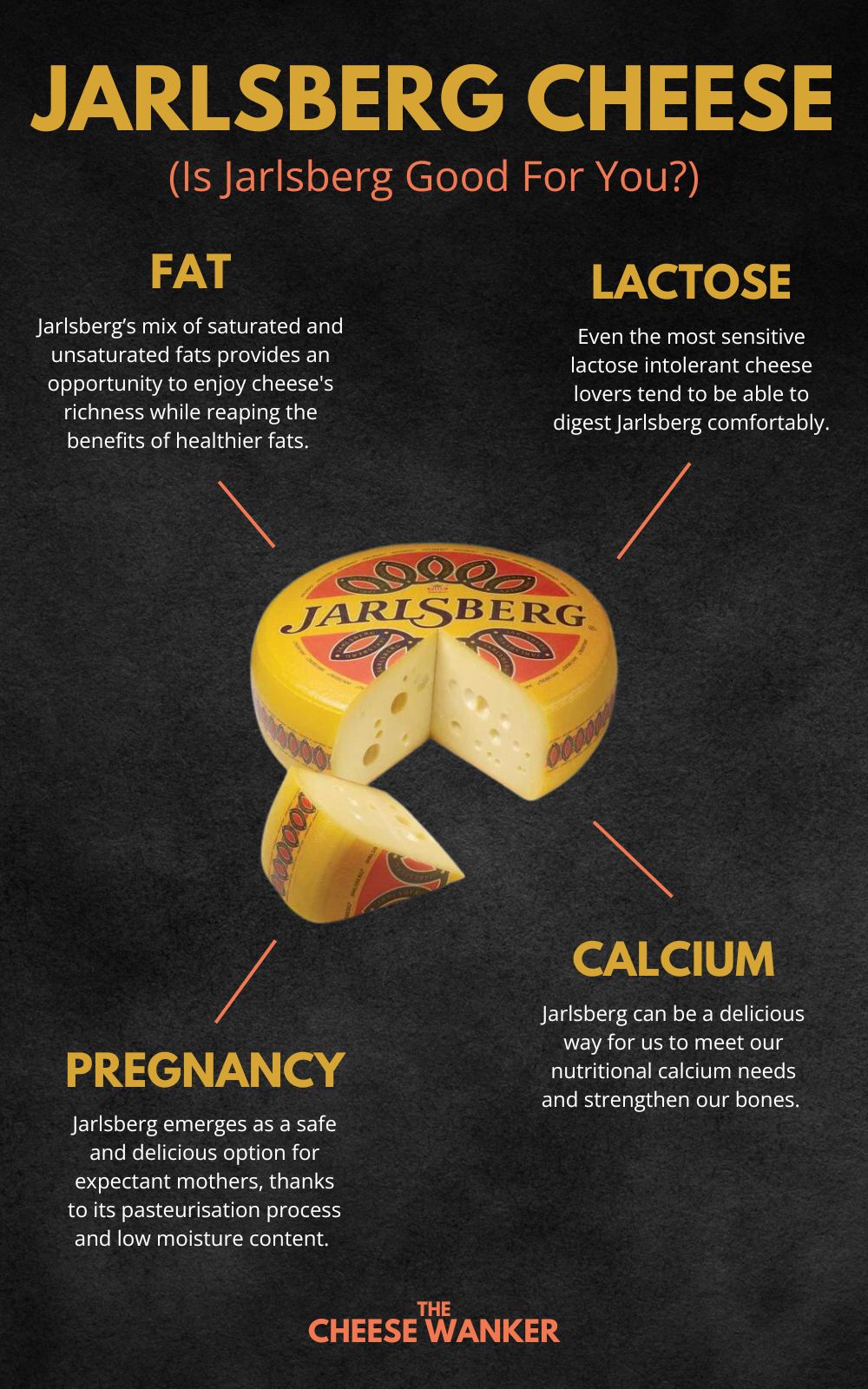
References
All the advice relating to what cheeses you can eat during pregnancy in this article is based on the recommendations by health authorities in Australia, the UK and the USA. If you are unsure about what you can or cannot eat, please consult your doctor.
Australia – FSANZ
United Kingdom – NHS
United Sates of America – FDA

